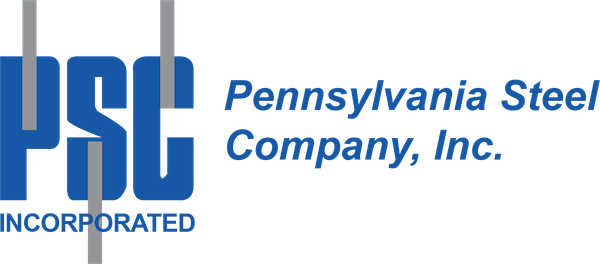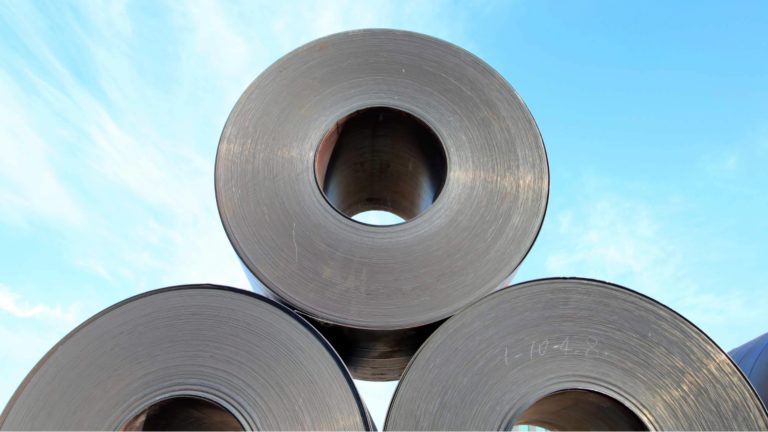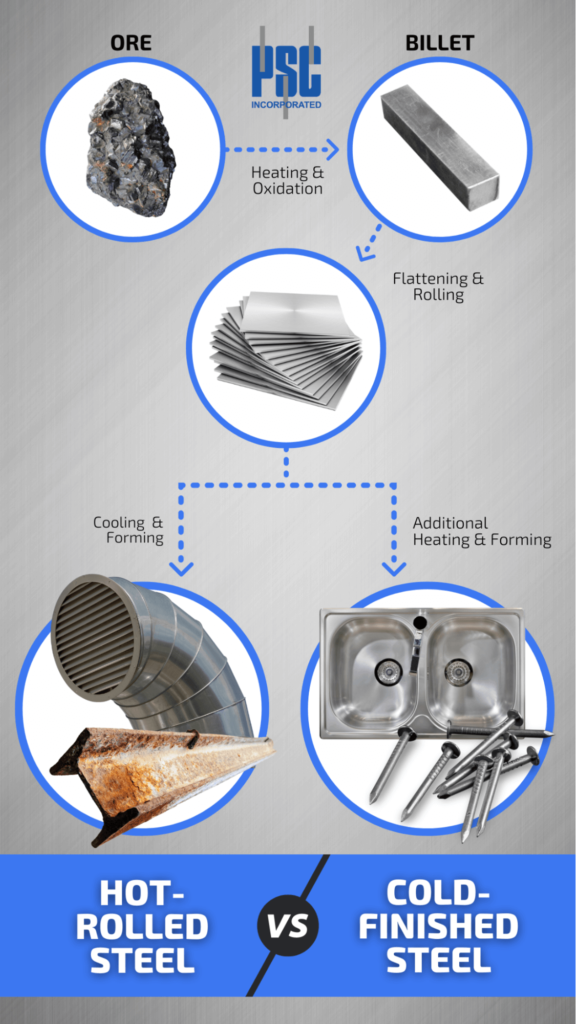Business owners and makers have thousands of steel varieties on the market to choose from. With such an array of metal options, selecting the correct type, grade, and finish of your building material can be tedious. Pennsylvania Steel Co. offers a vast assortment of premium steel products in Pennsylvania, Ohio, the Southeast, and New England. Plus, our online resources help our clients build the best projects possible.
Today, we’re breaking down hot rolled vs cold rolled steel to help you understand which is better for your application.
Steel Manufacturing, Summarized
Not to be mistaken with the four main types of steel, the general steel manufacturing process falls into two main categories: hot-rolled and cold-rolled. This process starts with the extreme heating and consequent oxidation of mined steel ore. Basically, pieces of large, rectangular metal called billets are heated and flattened into sizable rolls.
From there, the steel will either be hot rolled or cold rolled for its finalized design. “Rolling” refers to the vital step in the manufacturing process that involves forming the metal by using a series of rollers in an attempt to reshape it or enhance its properties. This formation method (hot or cold rolling) will determine the material’s ultimate function.
Hot Rolled vs Cold Rolled Finish Process
"In the conversation about hot-rolled vs. cold-finished products, all cold-finished products are hot-rolled, but hot-rolled products are not necessarily cold finished. Instead, it’s all a matter of how the bars are processed."
ryerson.com
Once steel is heated past its recrystallization temperature (over 1700º F) it can be easily formed and sized. If the material isn’t processed further at room temperature, it’s considered hot-rolled. The steel that goes through further refinement processes is categorized as cold-rolled. Explore further metal rolling methodology differences, capabilities, and tolerances below!
Hot-Rolled Steel
As hot-rolled steel cools, it tends to shrink and form asymmetrically, allowing for more variation in shape and size. For this reason, hot-rolled steel is used in projects where the finished product doesn’t have specific dimensional requirements.
For example, one of the most commonly recognized forms of hot-rolled steel is sheet metal, which is frequently used in creating air ducts and motor vehicles. In these applications, surface finish and proportions don’t need to be precise.
As a result, hot-rolled steel is typically cheaper in price simply because it doesn’t involve any further processing. Since it doesn’t require any reheating, production costs for hot-rolled steel are much lower.
Cold-Finished Steel
That being said, cold-rolled steel needs reheating to further refine its structural properties. In order to achieve more exact dimensions and surface quality, the metal is re-rolled at a lower temperature. This supplemental rolling results in more specified attributes including exterior finish, durability, and dimensional parameters.
PA Steel, for example, carries a variety of cold-finished bars in a range of grades and finishes for businesses all over the eastern United States. This equipment is used for creating products such as furniture, garages, and home appliances.
Although it’s typically up to 20% more durable than hot-rolled, cold-finished steel is limited to basic square, round, and flat shapes. Despite its improved resistance, the additional processing performed on cold-rolled metals may make it more susceptible to internal stress. Finalized materials need to be stress relieved prior to grinding or cutting to avoid potentially volatile warping or distortion.
Determining the Appropriate Steel Type
When considering hot vs cold rolled steel, the last step in the manufacturing process will influence the final product’s application. If tolerance, surface finish, symmetry, straightness, or aesthetics are a key factor in the project’s creation, cold-rolled steel is likely the ideal choice. Conversely, hot-rolled steel can be used for large-scale or low-budget operations that can account for dimensional changes as it cools.
Tolerance Variety
The table below outlines the varying tolerances of hot-rolled vs. cold-finished steel products:
Frequently Asked Questions
What are the environmental implications or sustainability factors associated with hot-rolled and cold-finished steel production processes?
The environmental implications of hot-rolled and cold-finished steel production processes differ significantly. Hot-rolled steel production generally consumes more energy due to the high temperatures involved, leading to higher greenhouse gas emissions. On the other hand, cold-finished steel may require more processing steps, potentially consuming more resources, but it can offer energy savings by not needing the extreme heat of hot rolling. Sustainability factors can vary depending on factors such as energy efficiency, material wastage, and water usage in each process.
How do the mechanical properties, such as strength, ductility, and toughness, differ between hot-rolled and cold-finished steel products?
The mechanical properties of hot-rolled and cold-finished steel products vary due to the different manufacturing processes. Hot-rolled steel typically has a rougher surface finish and less precise dimensions compared to cold-finished steel. Cold-finished steel tends to have improved dimensional accuracy, smoother surfaces, and higher tensile strength. Cold-finished steel may also exhibit better ductility and toughness compared to hot-rolled steel, making it more suitable for applications requiring precise dimensions and enhanced mechanical properties.
Are there specific industries or applications where cold-finished steel is preferred over hot-rolled steel and vice versa?
The preference for either cold-finished or hot-rolled steel in specific industries or applications depends on various factors. Cold-finished steel is often favored in industries requiring tight tolerances, excellent surface finish, and precise dimensional control, such as automotive manufacturing, aerospace, and construction. Hot-rolled steel is commonly used in structural applications where exact dimensions are less critical, such as in building construction, shipbuilding, and general fabrication. Understanding the requirements of the application, including factors like cost, aesthetics, and mechanical properties, helps in choosing the most suitable steel type for a particular industry or project.
Premium Steel and Pipe Supply From Pennsylvania Steel, Co.
Visit our new and improved website to browse our selection of high-quality products, including several varieties of cold and hot-rolled steel, plus carbon tubing, stainless steel, finished bars, and more. PA Steel Company employs an expert team of industry professionals that are prepared to supply you with the ideal metal for any size project. Browse our steel companies in Ohio, Pennsylvania, Richmond, Charlotte, Long Island, and more!
If you’re still having trouble figuring out the ideal steel production process for your project, check out our FAQ page or request a quote online today!






